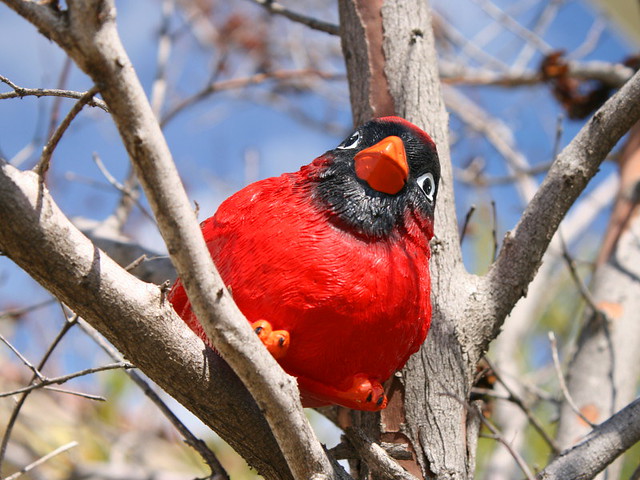 |
| Photo by “Caveman Chuck” Coker |
This is the male Cardinal we are talking about. The females have a more brownish color with hints of red. This enables them to blend in with their surroundings while sitting on the nest.
The Northern cardinal really stands out against the green and brown backdrops of the summer months. They stand out even more against a fresh sheet of new white snow. They winter within the U.S. and have a tendency to move North to Northeast when during late summer or early fall.
Cardinal Eggs
They are known for breeding in residential areas as well as in thickets, undergrowth, and dense shrubs. Redbirds are monogamous breeders with eggs that can be in a variety of colors. Some eggs are bluish, some grayish, and some a greenish-white. The eggs are marked with purples, grays, and browns.
They lay these eggs in a nest that can range from well lined to scarcely lined. The nests can be compact and firm or quite flimsy. They will use many building materials for their nests like-
• Leaves and Interwoven Paper• Weed Stems• Pliable Twigs• Hair• Fine Grass• Bark Strips• Rootlets
The chicks will develop from an Altricial state (helpless, blind, and naked). The Cardinal diet consists mainly of insects, seeds, and fruits.
Additional Information For Back Yard Bird Watchers
It was in the 50's when feeding birds out in the backyard became popular. It has been estimated that the annual expenditure for feeding birds out back in this country is over a half billion dollars. Nearly one out of three households contribute an average of 60 pounds of bird food yearly.
This might make it seem as if some species were dependent on us for their existence. While we are able to help in areas of need scientists believe that no species would become extinct if our handouts were to stop tomorrow. They foresee no drop in populations either.
The Northern Cardinal along with some others like the-
- • Red-Bellied Woodpecker
- • Tufted Titmouse
- • Mourning Dove
- • House Finch
Have all been the beneficiaries of range expansions due to human supplemental bird feeding. Some birds like the Mourning Dove have found migrating no longer a necessity with so much food being readily available. The rest of the bunch are still working their way Northward every year.
The generosity of backyard bird feeding individuals can sometimes pull a few weak birds through the tough times of winter. After a heavy snow or an ice storm, natural foods can become inaccessible.
Bird Watchers will notice their birds increasing their visits to the feeders during harsh winters.
Studies have shown certain small birds like chickadees can actually add around 4% more fat when they feed on sunflower seeds rather than their natural diets of berries and conifer seeds.
The drawback to the feeding stations is when they attract weakened birds that are carrying disease. Aspergillosis is a potentially deadly infection found in some molds on bread or damp grain. When birds inhale the mold that has been infected with Aspergillus fumigatus it can result in death.
Mating Displays
The male and female will stretch out their necks. With erect crests, they will begin singing softly and be swaying back and forth from one side to the other. The Cardinal is truly a backyard bird watcher delight.
|

No comments:
Post a Comment